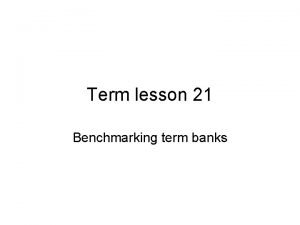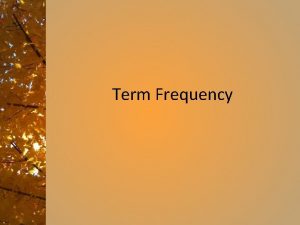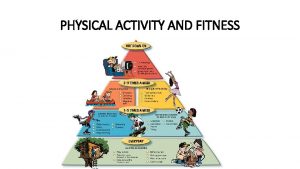Physical Activity 1 Physical Activity The term physical









- Slides: 9

Physical Activity 1

Physical Activity The term “physical activity” describes many forms of movement, including activities that involve the large skeletal muscles. Activities that involve the small skeletal muscles (e. g. playing board games, drawing, writing) are important, but they do not provide the health benefits of activities that involve the large skeletal muscles and require substantial energy expenditure.

1. Physical activity is a priority lifestyle that impacts health, wellness, and fitness. 2. Body movement carried out by skeletal muscles that requires energy 3. Physical activity essential to health, but exercise necessary to improve fitness 4. Increasing physical activity to improve health and wellness 5. People can obtain greater health and wellness benefits by increasing the duration and intensity of physical activity 2 -3

Physical activity is defined by its duration, intensity, and frequency • Duration is the amount of time spent participating in a physical activity session • Intensity is the rate of energy expenditure • Frequency is the number of physical activity sessions during a specific time period (e. g. one week).

Types of Physical Activity Aerobic - light to vigorous-intensity physical activity that requires more oxygen than sedentary behavior and thus promotes cardiovascular fitness and other health benefits (e. g. , jumping rope, biking, swimming, running; playing soccer, basketball, or volleyball). Anaerobic – intense physical activity that is short in duration and requires a breakdown of energy sources in the absence of sufficient oxygen. Energy sources are replenished as an individual recovers from the activity. Anaerobic activity (e. g. , sprinting during running, swimming, or biking) requires maximal performance during the brief period.

Lifestyle – physical activity typically performed on a routine basis (e. g. , walking, climbing stairs, mowing or raking the yard), which is usually light to moderate in intensity. Physical activity play – play activity that requires substantial energy expenditure (e. g. , playing tag, jumping rope). Play – activity with flexible rules, usually self-selected, for the purpose of having fun. Sports – physical activity that involves competition, scorekeeping, rules, and an outcome that cannot be predetermined. There are two categories of sports: individual and team. Weight-bearing – physical activity that requires people to move their own weight.

Benefits of Physical Activity

HEALTH BENEFITS • People who are usually inactive can improve their health and wellness by becoming even moderately active on a regular basis • Physical activity need not be strenuous to achieve health benefits • Greater health benefits can be achieved by increasing the amount of physical activity

• To produce health benefits, the intensity, duration, and frequency of activity is less than that required to produce improved fitness. • Improved fitness is measured by how much exercise you can do. Improved health is measured by improved physiologic function of body systems.
 What is physical fitness test in mapeh
What is physical fitness test in mapeh Long term plan and short term plan
Long term plan and short term plan In my understanding
In my understanding Long term memory vs short term memory
Long term memory vs short term memory Quadratic sequences formula
Quadratic sequences formula Short term human resources examples
Short term human resources examples Term to term rule
Term to term rule Difference between long term and short term liabilities
Difference between long term and short term liabilities Difference between long term and short term liabilities
Difference between long term and short term liabilities Minterm maxterm
Minterm maxterm

















